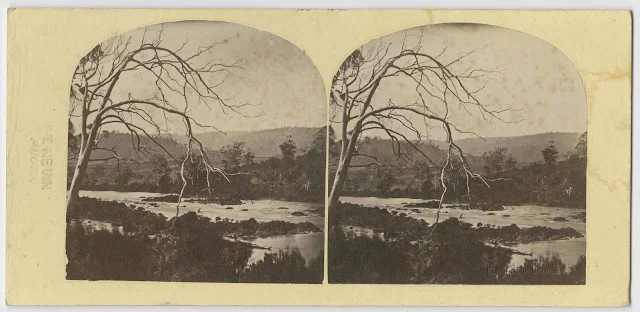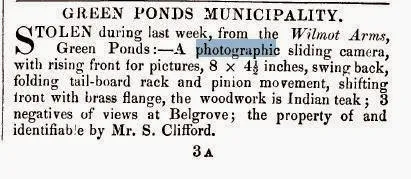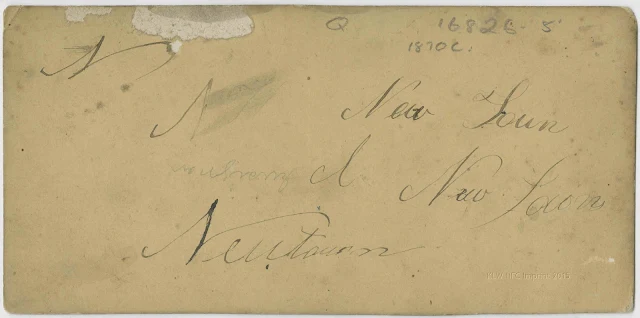Thomas Nevin at the Rocking Stone
Thomas J. Nevin submitted this stereograph in the Wellington Park Exhibition of 1870.

Group at the Rocking Stone, kunanyi/Mt. Wellington.
Stereograph on buff mount
Photographer: Thomas J. Nevin late 1860s
TMAG Ref: Q1994.56.4.
Exhibited at the Wellington Park Exhibition 1870.
The same image is attributed to Thomas Nevin but was catalogued differently in the TMAG's database in 2006, viz:
Ref: Q16826.4
ITEM NAME: photograph:
MEDIUM: albumen silver print sepia toned stereoscope,
MAKER: T Nevin [Artist];
TITLE: 'A Party at the Rocking Stone, Mount Wellington'
DATE: 1870s
DESCRIPTION : A group of people at the Rocking Stone on Mt. Wellington. Consists of 4 men and three women. The two women sitting on the ground in front of the rock appear to be sisters.
The "sisters" noted by the cataloguist here may have been the daughters of Captain James Day and his wife Rachel Pocock: the eldest, Elizabeth Rachel Day who married photographer Thomas J. Nevin in 1871, and her sister Mary Sophia Day who married Hector Axup in 1878.
Thomas Nevin on kunanyi/Mount Wellington
Fifty or so stereographs by Thomas J. Nevin are held at the Tasmanian Museum and Art Gallery. These stereographs were taken ca. late 1860s on and around the summit of kunanyi/Mount Wellington, copies sourced from the TMAG in 2015.

Snow on kunanyi/Mt Wellington "Plough Field"
Stereograph on buff mount
Thomas J. Nevin late 1860s
TMAG Ref: Q1994.56.16.Verso below.


A group at the Beacon Light, kunanyi/Mt. Wellington
Stereograph on buff mount
Thomas J. Nevin late 1860s
TMAG Ref: 1994.56.29. Verso below.


A large party sitting atop the Beacon Light, kunanyi/Mt. Wellington
Stereograph on buff mount
Thomas J. Nevin late 1860s
TMAG Ref: Q16826.7. Verso below.
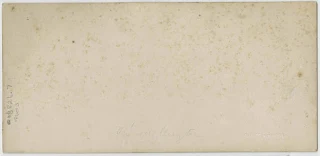

A group at the Rocking Stone, kunanyi/Mt. Wellington.
Stereograph on buff mount
Thomas J. Nevin late 1860s
TMAG Ref: Q1994.56.4.Verso below.


Three men sitting on boulders, kunanyi/Mt. Wellington
Stereograph on buff mount
Thomas J. Nevin late 1860s
TMAG Ref: Q16826.32. Verso below.


Ferns covered in snow, kunanyi/Mt. Wellington
Stereograph on buff mount
Thomas J. Nevin late 1860s
TMAG Ref: Q16826.31.1. Verso below.

[Above] A selection of stereographs taken by Thomas J. Nevin, late 1860s, on and around the summit of kunanyi/Mount Wellington. From the Tasmanian Museum and Art Gallery Collection 2015
Samuel Clifford at the Rocking Stone
Another group at the Rocking Stone was photographed by Thomas Nevin's friend and partner Samuel Clifford a few years earlier:

The Rocking Stone
Publication Information:ca. 1860.
Physical description:1 stereoscopic pair of photographs : sepia toned ; 8 x 8 cm. each, on mount 9 x 18 cm.
Notes: Label on verso reads: Views in Tasmania. Curiosities of Mount Wellington. S. Clifford, photographer, Hobart Town ; inscribed below label in ink: The Rocking Stone.
Title inscribed in ink on centre of verso ; no. 115 inscribed in ink lower left of verso.
Date and accession number in pencil upper right corner of verso.
Exact size 74 x 73 mm. each, on mount 86 x 175 mm.
Citation: Digitised item from: W.L. Crowther Library, Tasmanian Archive and Heritage Office
The tall man with the stick on the viewer's left was possibly Mr. Woods who lived half way up the mountain at the Springs with his wife, son and daughter, and acted as a guide for visitors. They provided food and water as well, according to the visitor's account below:
The old man & woman who reside at the hut supply visitors with implements and cook what provender they may take with them for which 1/- per head is generally presented to them. We arrived there at 1/2 past eight & were glad to sit down to an excellent breakfast of cold lamb and coffee. We also enjoyed a draught of the cold crystal water from the murmuring spring....This visitor to Tasmania from NSW in 1865 recounted her walk up kunanyi/Mount Wellington in a diary in which she had pasted photographs by Samuel Clifford, now held at the State Library of NSW:
TRANSCRIPT
A Lady's Trip to Tasmania by M. Swyny
On the 10th of January I ascended Mount Wellington with a small party of friends, 2 ladies and 4 gentlemen. We set of at 6 in the morning & drove to the foot of the mountain. The sky was clear & the bright sun-shine & fresh breeze invigorated us all on our toilsome ascent. The path is narrow & very steep, it is said the slope is at an angle of 45 degrees. It is covered with loose flat stones as
[page 21]
if flags had been broken up and thrown pell-mell over it; in some places it was not improved by being very sloppy. Our progress was slow as we required to stop frequently to take breath & to rest, and like Mr David Price in Ingoldsby "we paused and looked down on the valley below". The Captain of the party pushed forward to the hut at a place called the Springs to have breakfast prepared for us. The water flows down the mountain to the city. It is conveyed by a channel cut in the earth (about three feet wide). The old man & woman who reside at the hut supply visitors with implements and cook what provender they may take with them for which 1/- per head is generally presented to them. We arrived there at 1/2 past eight & were glad to sit down to an excellent breakfast of cold lamb and coffee. We also enjoyed a draught of the cold crystal water from the murmuring spring. At a little before ten we again sett off staff in
[page 22]
in hand for the top of the mount. At first a little level ground was our path but soon the steep and rugged way obliged us to rest; but the prospect repaid our toil for at each succeeding halt some new beauties were revealed to our view. The last ascent is more steep than the rest and is locally known by an expressive but inelegant nickname. Here we rested about 10 minutes & listened to a very beautiful echo. Some children were coming up the path singing one of the Christy's songs, and for a moment the last notes were repeated with much clearness. One of our party called out "Wellington" which was distinctly repeated once & some words answered twice. Our next exploit was to cross the "Ploughed Field"; a very odd name for a mass of confusion. It consists of large stones but to clear head and firm foot they do not present any great difficulty and we all agreed
[page 23]
that we would much rather traverse them than climb the last hill. We again rested when we had crossed this chaos & then pushed on over rugged ground with stones of all sizes and shapes from 6 or 8 feet in height to those of as many inches, interspersed with tufts of stunted, withered, grass and some bright flowers, which were but a few as the spring time was past. After more than a mile's walk we reached the Pinnacle at 10 minutes past twelve. This is the most elevated point of the mount and a sort of casing of wood has been placed round the rough stones, up which we climbed & sat on the top & beheld one of the most lovely prospects in the world. There was neither mist nor cloud to overshadow the panorama of a hundred miles. To the left were dark mountains and Adamson's Peak capped with snow. The Huon river like a blue ribbon winding its way though
[page 24]
the dark trees. The Ocean and the entrance to the Derwent were clearly visible as well as Bruin Island and Dentrecasteaux Channel . All the windings of the Derwent with its many white beaches & its sapphire waters from Storm Bay to New Norfolk were laid out before us like a beautiful picture. The city of Hobart was at our feet the streets and buildings well defined & the reservoirs looking like small blue lakes. The Public Gardens could be seen marked out like a plan. Having refreshed ourselves with a slight repast we had brought with us we descended gathering ferns and flowers on our way and reached the Hut about 4 o'clock . We made an excellent tea after which we sat outside the door taking a good rest before we attacked the last stage of our journey. The Captain of the party wrote our names in the book & when the old man heard that one of us was from N.S.Wales he began to ask
[page 25]
some questions about a family he had been coachman to some 37 years ago asking how Master Robert and Master George were regardless of the lapse of time which had made the young men he had left grey headed fathers. We passed down the path at a more rapid rate than we had ascended but still found our long staves very useful to steady us. When we reached the foot we went along a new road that is being made to the Huon and obtained several fossils from the cutting. We were delighted to see the carriage and drove home unconscious of the flowers we had all wreathed around our hats. A warm bath concluded the day & ten o'clock found us sleeping. It is not considered safe to ascend the mountain without a little brandy as sometimes a faintness comes over those who are not very strong & they would not be able to proceed without the aid of a stimulant. There
[page 26]
is only one habitation and that not far up the mountain. Last year an invalid Doctor from India went up with a party of gentlemen. He was too much fatigued after reaching the summit of the last hill to proceed any further. His friends left him to rest while they went on to the Pinnacle. When they returned they were dismayed to find the Doctor had left his resting place. They searched that evening in vain but returned in the morning to find him dead. He was sitting upright against a rock not very far from where they had left him. The event created a great sensation. In his pocket were found the portrait and letters of a lady to whom he was to have been married. "Truth is strange, stranger than fiction". There is a great extent of ground on the top of the mountain where people often have been lost for a time. Lately some land marks have been placed as
[page 27]
guides in the confusion. Some long poles have been set up to shew the track over the Ploughed Field & small stones piled one on another at short intervals direct the way to the Pinnacle.

State Library of NSW
Call Number: MLMSS 588
1865-1866; 'A Lady's Trip to Tasmania', being an account of a holiday trip, Dec. 1865 to Jan. 1866. Author unknown, presumed a member of the Swyny family.
The account includes copies of photographs of Hobart by Samuel Clifford (Call No.: MLMSS 588/item 1)
Samuel Clifford: footsore on kunanyi/ Mt Wellington 1865
Thomas Nevin's close friend and colleague Samuel Clifford made a photographic excursion to the Falls (Springs) half way up kunanyi/Mount Wellington on February 9th, 1865, and regretted he had not worn the appropriate foot wear. This is his note left in the Visitors' book:
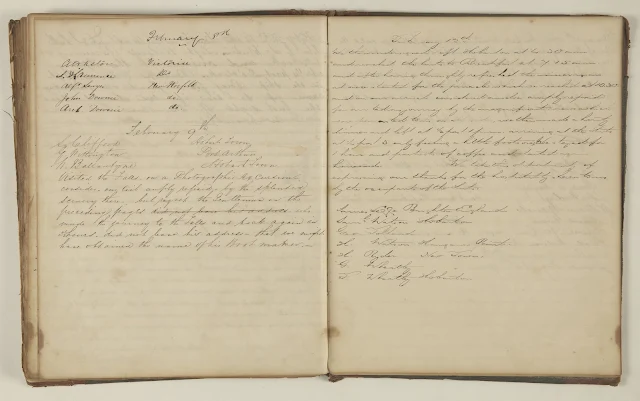
Visitors Book: kunanyi/Mount Wellington
Item Number: NS4160/1/1
Description: Vistors Book
Further Description:
Start Date: 04 Dec 1860
End Date: 31 Oct 1865
Source: Archives Office of Tasmania
TRANSCRIPT
February 9thThis is the place where the guide to the mountain Mr. Woods and his family resided and where the visitors to the Falls signed the Visitor's Book, photographed by Samuel Clifford on this visit or later, reprinted with the date ca. 1873. A photograph of Samuel Clifford on kunanyi/Mt. Wellington also survives, taken by another photographer, probably Clifford's friend and collaborator Thomas Nevin.
S. Clifford Hobart Town
G. Wittington Port Arthur
H. Ballantyne Hobart Town
Visited the Falls on a Photographic Excursion, consider our trip amply repaid by the splendid scenery but regret the Gentlemen in the preceding pages [did not leave his address = struck through] who made the journey to the Falls and back again in 2½ hours did not leave address that we might have obtained the name of his Boot maker. -
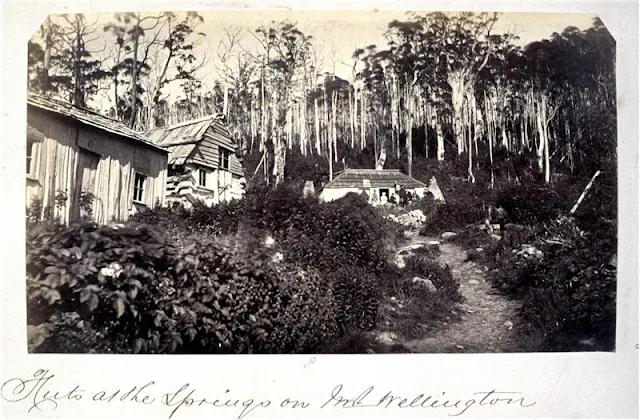
Archives Office Tasmania
Huts at the Springs on kunanyi/Mt Wellington [ca. 1873]
Physical description: 1 photograph : sepia toned ; 11 x 19 cm.
Notes: Title inscribed in ink below image ; date noted in pencil at lower right of image on album page ; item number noted in ink at centre left of image on album page.
Exact size 105 x 184 mm. "Tasmanian scenes" also known as "Clifford album 1".
kunanyi/Mount Wellington with the Derwent Entertainment Centre foreground, taken from the River Derwent.
Photo copyright © KLW NFC Imprint 2015 ARR.
RELATED POSTS main weblog


